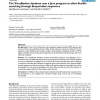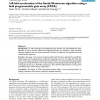BMCBI
2008
13 years 12 months ago
2008
Background: Viruses of the Bunyaviridae have segmented negative-stranded RNA genomes and several of them cause significant disease. Many partial sequences have been obtained from ...
BMCBI
2008
13 years 12 months ago
2008
Background: The current versions of the COG and arCOG databases, both excellent frameworks for studies in comparative and functional genomics, do not contain the nucleotide sequen...
BMCBI
2008
13 years 12 months ago
2008
Background: Ultraconserved elements are nucleotide or protein sequences with 100% identity (no mismatches, insertions, or deletions) in the same organism or between two or more or...
BMCBI
2007
13 years 12 months ago
2007
Background: The secondary structure of an RNA must be known before the relationship between its structure and function can be determined. One way to predict the secondary structur...
BMCBI
2008
13 years 12 months ago
2008
Background: Visualising the evolutionary history of a set of sequences is a challenge for molecular phylogenetics. One approach is to use undirected graphs, such as median network...
BMCBI
2008
13 years 12 months ago
2008
Background: The number of available genome sequences is increasing, and easy-to-use software that enables efficient comparative analysis is needed. Results: We developed GenomeMat...
BMCBI
2007
13 years 12 months ago
2007
Background: To infer homology and subsequently gene function, the Smith-Waterman (SW) algorithm is used to find the optimal local alignment between two sequences. When searching s...
BMCBI
2010
13 years 12 months ago
2010
Background: Primer and probe sequences are the main components of nucleic acid-based detection systems. Biologists use primers and probes for different tasks, some related to the ...
BMCBI
2007
13 years 12 months ago
2007
Background: Most single stranded RNA (ssRNA) viruses mutate rapidly to generate large number of strains having highly divergent capsid sequences. Accurate strain recognition in un...
BMCBI
2007
13 years 12 months ago
2007
Background: By virtue of their shared ancestry, homologous sequences are similar in their structure and function. Consequently, multiple sequence alignments are routinely used to ...





